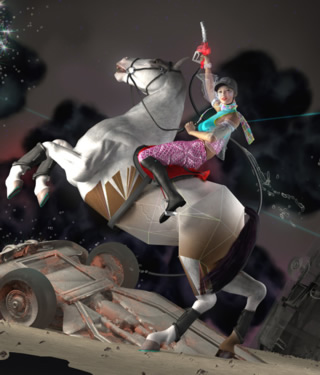Out of this World - Page 3
 |
|
|
The Internet has become the greatest sales tool of all time, and what it's selling is information about us. And in a world in which all content, music, writing, illustration is expected to be free, creative types have it even worse.
Their contributions whiz by in a sea of words, sounds, and images. They are copied, blended, altered, ‘stolen'—a word today without meaning. People are no longer individuals, just contributors to the cloud.
“Crowd sourcing!” Laura says. “Hey, it's just the way it's going to be.”
 |
|
|
Justin's art depicts this virtual world, a world in which he grew up. He portrayed “the ultimate hack” in an early work based on cyberpunk science fiction by William Gibson, and he's won particular repute for his skill at “literal representations of data.”
“Because I was working on the computer, people always thought I would be the best person to handle that,” he says. It also might have helped that his images of literal data often include strikingly attractive women.
One person who's fond of Justin's delineations of data is Scott Dadich, who's been called ‘Condé Nast's digital savior,' and was Justin's editor in the mid- and late-2000s at Wired. “At Wired we try to illustrate the intangible,” Dadich says. “Bits. Abstract concepts.”
 |
|
|
“He [Justin] was one of the first illustrators I came across who worked using a 3-D program for art of this sort,” says Dadich, Condé Nast's digital design director. “It was a tool typically reserved for realistic or photo-realism, trying to render a person or a scene to look real. He was one of the first to blend that realism with more of a synthetic, artistic point of view.”
In recent years, other artists have adopted similar techniques but Dadich says, “No others come close to Justin's eye. I think he does have a singular vision.”
Justin might just be the quintessential artist for these early, disturbed years of the 21st century, where doomsayers duke it out with technophiles who foresee Internet immortality.
“You wonder what the point is of being human in this world,” Justin says. “That sounds pretty dark, I suppose.”
“This utopia of the digital age, this living in a virtual space,” Justin muses. “Maybe it's not all it's cracked up to be.”
One of Justin's collectors, Andrew Wilder, appreciates his work in part because it is so much of today.
“It's so cold,” Wilder says—and he means that in a good way. “It feels very much an expression of the computer age. But there's so much talent behind it.”
“Why hasn't this guy become a major artist yet?”
 |
|
|
Since graduating in 2001 with a degree in commercial art (and no debt—he was on scholarship), Justin has illustrated for Outside, Men's Health, Fortune, Entertainment Weekly, and many other magazines. He created in-story designs for retailer Target (which didn't use them) and for Sony Stores.




